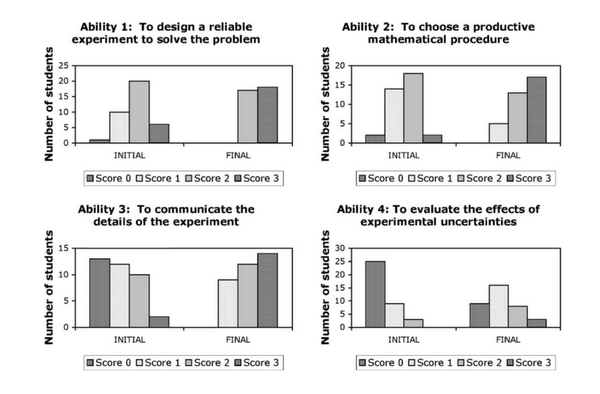Developed by Eugenia Etkina, Alan Van Heuvelen, Suzanne White-Brahmia, David T. Brookes, Michael Gentile, Sahana Murthy, David Rosengrant, and Aaron Warren
| Purpose | To help students self-assess and improve their work and to help instructors assess students’ scientific abilities as evidenced in their writing around experiments and design tasks. |
|---|---|
| Format | Rubric |
| Duration | N/A min |
| Focus | Scientific reasoning (represent information in multiple ways, design and conduct experiments, communicate scientific ideas, collect and analyze experimental data, evaluate experimental results) |
| Level | Upper-level, Intermediate, Intro college, High school |

more details
This is the second highest level of research validation, corresponding to at least 5 of the validation categories below.
Research Validation Summary
Based on Research Into:
- Relevant theory and/or data
Studied Using:
- Iterative use of rubric
- Inter-rater reliability
- Expert review
Research Conducted:
- At multiple institutions
- By multiple research groups
- Peer-reviewed publication
The SAARs were developed based on “the history of the practice of physics, the taxonomy of cognitive skills, recommendations of science educators and an analysis of science-process test items.” (Etkina et al., 2006) Once the authors had the list of abilities, they broke up each ability into smaller sub-abilities that could be individually assessed with a rubric, and created a rubric for each of the seven abilities. The developers then used the rubrics to assess student work, and discussed discrepancies in scores and refined the rubrics. They repeated this process of rubric refinement until they reached an 80% agreement level on the rubric scores. The results of using the SAARs are published in one peer-reviewed publication.
References
- E. Etkina, A. Van Heuvelen, S. White Brahmia, D. Brookes, M. Gentile, S. Murthy, D. Rosengrant, and A. Warren, Scientific abilities and their assessment, Phys. Rev. ST Phys. Educ. Res. 2 (2), (2006).
We don't have any translations of this assessment yet.
If you know of a translation that we don't have yet, or if you would like to translate this assessment, please contact us!
| Typical Results |
|---|
These SAARs have been used to look at how introductory physics classes influence students' scientific abilities. The developers tested these rubrics in their introductory physics lectures and labs and found the results shown below for a sub-set of the scientific abilities (Etkina et al., 2006).
|
The latest version of the SAARs, released in 2014, is Version 5.




